The word xeriscape, coined to describe a garden in which little water is needed, has suddenly become a popular addition to many home gardeners’ vocabulary. The xeriscape concept, and the very word itself, were created in Denver after a severe drought intensified the city’s water problems in 1981. That summer also served as a warning for the future, making it clear that the city’s exploding population growth could easily overwhelm water resources, even in non-drought years. Because approximately half of the tap or drinking water used every year in Denver was used on lawns or gardens, city officials, along with botanists and landscapers, began to hunt for ways to create lawns and gardens that would be more water efficient.
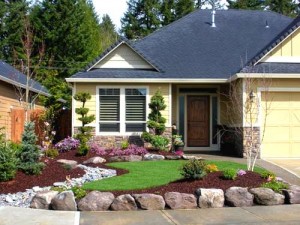
Xeriscape gardens have become increasingly sophisticated. They’re no longer simply yucca and cactus. Today’s xeriscape garden can be as lush and colorful as an English cottage garden say landscape professionals. It’s even possible to include every single one of your favorite flowers and shrubs and still reduce your water usage by fifty percent. Water-efficient gardens do more than conserve a precious natural resource. They save money, especially if you live in an area where water use is metered. In addition, you won’t have to invest so much time and energy maintaining a xeriscape flower bed or lawn.
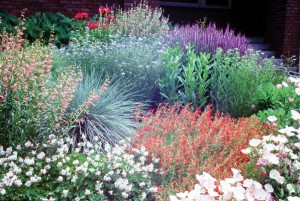
Here are 7 important steps to creating an effective and efficient xeriscape garden:
1. Plan a Comprehensive Design Before You Begin. Ask yourself some questions before you design: How do you use your outdoor space now? Is outdoor entertainment an important part of your life? Do you enjoy working in the garden or do you want one that is easy-care? The most important thing to remember is that landscapes can be tailored to increase the things that gardeners like to do while decreasing the things they don’t like to do. Keep this is mind. While working on your plan remember that you don’t have to do everything at once.
2. Create Practical Lawn Areas. According to experts, bluegrass lawns are probably the biggest “water hogs” in the American landscape. These lawns are also labor-intensive due to their need for extensive mowing and maintenance. You might consider replacing Kentucky Bluegrass with a variety called Blue Grampa. It requires a lot less water and, because it only grows to a height of six inches, needs much less mowing. Many universities, especially in the western part of the USA are working to create new lawn seeds that are water-efficient. You can always check with your local garden center and find out what new grass seeds are available in your area.
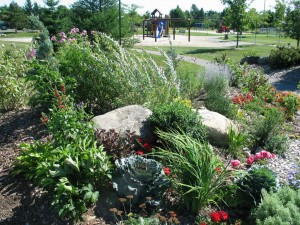
3. Zone-Plant Low-Water or High-Water Flowers and Shrubs Together. To get the maximum benefit of the water you use in your garden, plant things that have similar water needs. That way, you won’t overwater or underwater your plants. You’d be surprised at which plants need less water. Tulips and lilacs, for instance, might seem to need a lot of water but are actually very drought-resistant. Finding low-water flowers or shrubs is not as difficult now as it was a few years ago. Again, consult your local garden center for guidance about which plants need less water.
4. Improve Your Soil. All gardens need enrichment. Generally you should try to work an equal amount of compost or manure into the soil you intend to use for a flower bed. Compost or manure not only provide plant nutrients, they also help the soil to retain moisture. A win-win!
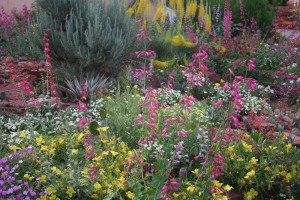
5. Mulch. Mulching is a great water conservation technique because it prevents water from evaporating too quickly and soil from drying out. Wood chips, bark and other natural mulches work well. You may also want to check out some polymer soil additives. These beads or crystals will swell and retain water after they’ve been worked into the soil. They work especially well with container gardening because they reduce the number of times a week you have to water. This is especially helpful when you are on vacation and worried about keeping your garden going while you are away.
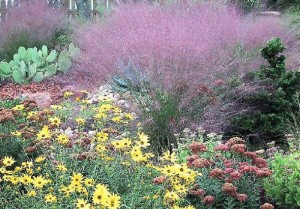
6. Irrigate Efficiently. Sprinklers are great for lawns but they do waste a lot of water through evaporation. Drip systems work well for flowers and shrubs but don’t work for lawns. So, the best solution is to use both systems. Also, most people water twice as much as they have to. Your local garden center can give you some guidance on how much water each area of your lawn and garden needs weekly. And, try to avoid watering during the hottest hours of the day. You’ll end up losing a lot more water to evaporation.
7. Practice Smart Maintenance. If you’ve prepared your garden carefully, you won’t have to do much weeding. However, be aware that a xeriscape lawn and garden will still need to be watered, mowed, fertilized and pruned. Make a plan so that you will know how much time you need to devote to each chore monthly.
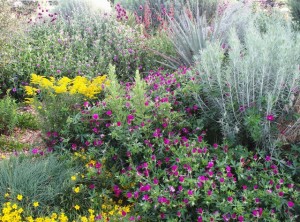
Xeriscaping makes so much sense! You can have an amazing lawn and garden and feel proud at the same time that you have conserved water and helped the environment. It’s all good!

0